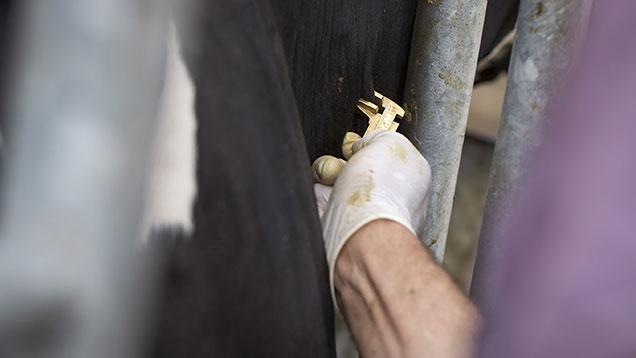Vet Viewpoint: Sheep scab and silage clamp safety
 © Geoff Pagotto
© Geoff Pagotto Steve Trickey – Chapelfield Vet Partnership, Norfolk
I recently removed a magnet from a dairy cow during a rumenotomy, to find it covered in tyre wire. This highlights the need to look at silage clamps, feeding procedures and prevention measures.
See also: BVD Control
Hopefully in a month or so, silage clamps will be full again. If using tyres to cover the clamp, please check and discard any tyres which are damaged to prevent wire getting into the clamp. Educate all staff mixing rations the importance of moving tyres away from the clamp face to prevent tyres going through the mixer wagon.
Placing a magnet in every cow will cost the average sized herd much less than the cost of losing one cow. Placing a magnet at drying-off makes the prospect of doing the job less daunting, but it may be necessary to place extra magnets every couple of years.
Kathryn Stewart – Belmont Vet Centre, Herefordshire
As many spring calving herds are coming to the end of their block, it is important not to let hygiene lapse.
Cows calving later are already running behind the rest of the herd and any intervention at calving could potentially push her back further when returning to service; risking an extended calving or even a barren cow next year.
Always wear gloves when assisting with calvings; disinfect ropes and equipment between uses and keep calving areas clean and well bedded.
Calves born later will be at higher risk of picking up infections from the environment due to a build-up of bacteria and viruses over the housing period and an increase in stocking rates with more calves on the ground.
Ensure all calves receive 2-4 litres of colostrum within the first six hours of life and navels are dressed.
Chris Aitken – Thrums Vet Group, Angus
We are currently trying to control an outbreak of sheep scab in an area which has been free of scab since 2007.
See also: Tackling scab in sheep
Infected flocks have to sell finished lambs directly to slaughter; then treat their remaining sheep.
Neighbouring premises also need to treat, and several have taken advantage of Moredun’s new scab Elisa test to check for exposure.
Flocks with a positive result give a repeat treatment, while negative flocks can avoid the hassle of re-treatment.
Hopefully co-operation among farmers, local vets, AHPA and the local Inspector working to the Scottish Sheep Scab Order will ensure that this area is soon scab free again.
And all of this could have been avoided by following basic biosecurity and quarantine protocols when bringing home new stock.
Jonathon Stockton – Kingsway Vet Group, North Yorkshire
We are starting to see more poorly cows, often off their food and sometimes scouring, along with more left and right displaced abomasums.
These occur more often at this time of year as silage fibre quality can deteriorate over the winter, the quantity available of the usually better first-cut silage reduces and farmers’ feed more of the poorer quality forage.
In addition, silage at the face can become less stable, due to the improving ambient temperatures, resulting in poorer intake potential.
To attempt to prevent these problems it is important re-analyse the silage being fed and to monitor intakes carefully, to reassess silage stocks and to correct any decrease in fibre content of the diet.
Changes in silage quality due to stability issues often result in higher ammonia, so additional energy may be required to utilise this.
